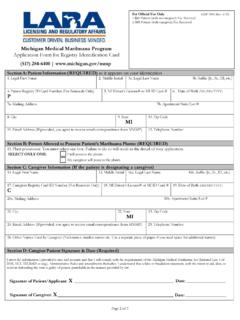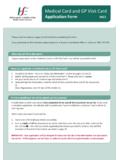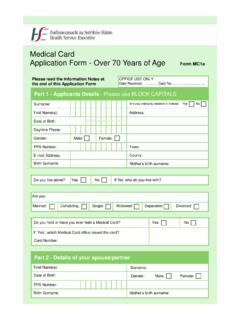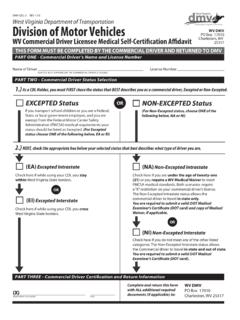Transcription of 09 Lecture 9 (Infective Endocarditis) - Columbia …
1 MID 9 infective EndocarditisInfective endocarditis Definitions and Historical Perspective Definitions and Historical Perspective Epidemiology Pathogenesis Clinical Presentation and Diagnosis Therapy Therapy PreventionMID 9 infective endocarditis : Definitions A microbial infection of a cardiac valve or the endocardium caused by bacteria, fungi, or chlamydia Often categorized as acute or subacute based on the rapidity of the clinical course Alternatively described by type of risk factor ,nosocomial, prosthetic valve, intravenous drug use - associated Pathological findings include the presence of friable valvular vegetations containing bacteria, fibrin and inflammatory cells.
2 There is often valvular destruction with extension to adjacent jstructures. Embolic lesions may demonstrate similar findingsMID 9 Historical Perspective .. A concretion larger than a gpigeon s egg; contained in the left auricle. Burns, 1809 Osler s Gulstonian lectures provided the 1st comprehensive overview of the disease Lewis and Grant (1923) were the first to link a transient bacteremia with deformed valves as the two predominant a esast et opedoa trisk factors for infection The introduction of penicillin marked the first successful therapy for this otherwise fatal infectionSir William OslerEpidemiology of endocarditis Incidence the same or slightly increased ,000 depending on the population pg pp The age of subjects with endocarditis has increased over the past 60 years (30-40 to 47-69)
3 There has been a major shift in nature of underlying valvular disorders There has also been a change in the microbiology of casescases Increasing incidence of staphylococci MID 9 Epidemiology of endocarditis There has been an increasing incidence ofThere has been an increasing incidence of nosocomial endocarditis - both native and prosthetic valve There is an increased risk of IE among injecting drug users, patients on long-term hemodialysis, patients with intravenous catheters, diabetics and HIV-infected patientsinfected patients Among injecting drug users the incidence is as high as 150-2000/100.
4 000 person yearsIncidence of Underlying Heart Disease in infective endocarditis *Pre-Antibiotic EraPresentPre-Antibiotic Era PresentRheumatic++++^+Congenital++Degene rative+++Mitral valve prolapse++++Normal valves+++_____*Incidence varies with population studied^ Relative incidenceMID 9 Microbiology of infective endocarditis Prospective International Cohort StudyOrganismsStaphylococcus aureusPercent Cases32 Staphylococcus aureusCoagulase-negative staphylococciViridans group streptococciStreptococcus bovisOther streptococciEnterococcus negatives (including HACEK)Fi321018651142 FungiPolymicrobialCulture negativeFowler, et al.
5 , JAMA 2006218 Risk Factors for Specific Pathogens that Cause infective endocarditis Dental procedures, poor dental hygiene - viridans streptococci, nutritionally variant streptococci, HACEK Prosthetic valves Early: coagulase negative staphylococci, S. aureus Late: coagulase negative staphylococci, viridans streptococci Gastrointestinal or genitourinary procedures - enterococci or S. bovis (colon carcinoma) Nosocomial -S. aureus (including MRSA), Gram negatives, Candida speciesCandida species Brouqui and Raoult, Clin Microbiol Rev, 2001 MID 9 Pathogenesis of endocarditis Inoculation of bacteria colonizing a mucosal ( , oral mucosa)
6 Or peripheral tissue site into the bloodstreamor peripheral tissue site into the bloodstream Transient bacteremia of a serum-resistant pathogen capable of adhering to a cardiac valvular surface Turbulent blood flow across the valve Bacterial adherence to cardiac valvular surface Pathogen - host tissue interaction resulting in vegetation formation and local tissue damage Bacterial persistencep Dissemination of infection to other tissue sites and elicitation of systemic findingsValvular endotheliumMucous membranes -other peripheral tissuePathogenesis of infective EndocarditisTrauma - damage at tissue surfaceCongenital abnormalities, turbulent blood flowNonbacterial thrombus,Native valvesTransient bacteremia Adherence and colonizationPlatelet adherence, fibrin deposition - vegetation formation Elaboration of bacterial enzymes, proteasesMID 9 Factors Contributing to the Pathogenesis of endocarditis Hemodynamics-blood flow patterns Hemodynamics -blood flow patterns Bacterial properties Host factors Hemodynamics of EndocarditisRodbard, Circulation.
7 1963 MID 9 Hemodynamics of EndocarditisWeinstein, Schlesinger NEJM, 1974 Bacteremia of EndocarditisBeeson et al., JEM, 1945 MID 9 Bacterial Factors Involved in the Pathogenesis of infective endocarditis Serum resistance complementSerum resistance complement Gram positives tend to be complement resistant Bacterial adhesins mediate binding to the nonbacterial thrombus and to endothelial cells: dextran, fibrinogen-binding proteins Invasive potential of bacteria Ability to elaborate extracellular proteases Capacity for metastatic seeding Stimulation of tissue factor activityHost Factors Involved in the Pathogenesis of infective endocarditis Valvular surfacesa u a su aces Nonbacterial thrombus forms on damaged valves Direct adherence to the endovascular surface of normal valves Suture line, valve surface of prosthetic valves Platelets dual role Platelet microbicidal proteins ( -granules)
8 Bacteria induce platelet aggregation Part of nonbacterial thrombus surface Leukocytes, complement, cytokines More limited roleMID 9 Immunologic Manifestations of infective endocarditis Hypergammaglobulinemia; both antigen specific and polyclonal yp gg;gpp yB cell activation ( ,rheumatoid factor) May block IgG opsonic response, accelerate microvascular damage or stimulate phagocytosis Vasculitis Circulating immune complexes Hypocomplementemia Clinical syndromes: Lumpy-Bumpy glomerulonephritis with Ccasydoes upyupygoeuoep ts tdeposition of complexes plus complement, Osler s nodes MID 9 The Pathogenetic Basis for the Clinical Manifestations of infective endocarditis Valvular destruction and local intracardiacValvular destruction and local intracardiac complications Bland or septic embolization of vegetations Sustained bacteremia Immunologic phenomenaOsler, Gulstonian Lectures, Lancet, 1885 Weinstein and Schlesinger NEJM, 1974 Case 1.
9 One Sick DudeA 33 yearold recreational drug user developsA 33 year-old recreational drug user develops fever, chills and pleuritic chest pain 48h after injecting heroin. He appears acutely toxic with a temperature of 104 , rapid respirations and agitation. His sputum is purulent and bloody. His cardiac exam is unremarkable except for his sinus tachycardia. Examination of his skinhis sinus tachycardia. Examination of his skin reveals a petechial rash and a small soft tissue abscess at his injection site. MID 9 MID 9CT Scan of the LungCase 1: One Sick DudeHi bl dltitifSHis blood cultures are positive for S.
10 Aureus within two days. One week into therapy he is feeling better, however he has noticed some increased left upper quadrant pain and on examination you are able to palpate his spleen. He also has developed a soft systolic murmur at his left lower sternalsystolic murmur at his left lower sternal border that is increased with 9 The Sluggish DocA 65 year old female physician has noted increasingA 65 year old female physician has noted increasing fatigue and malaise for the past 1-2 months. When she takes her temperature she is surprised to find that it is.
















